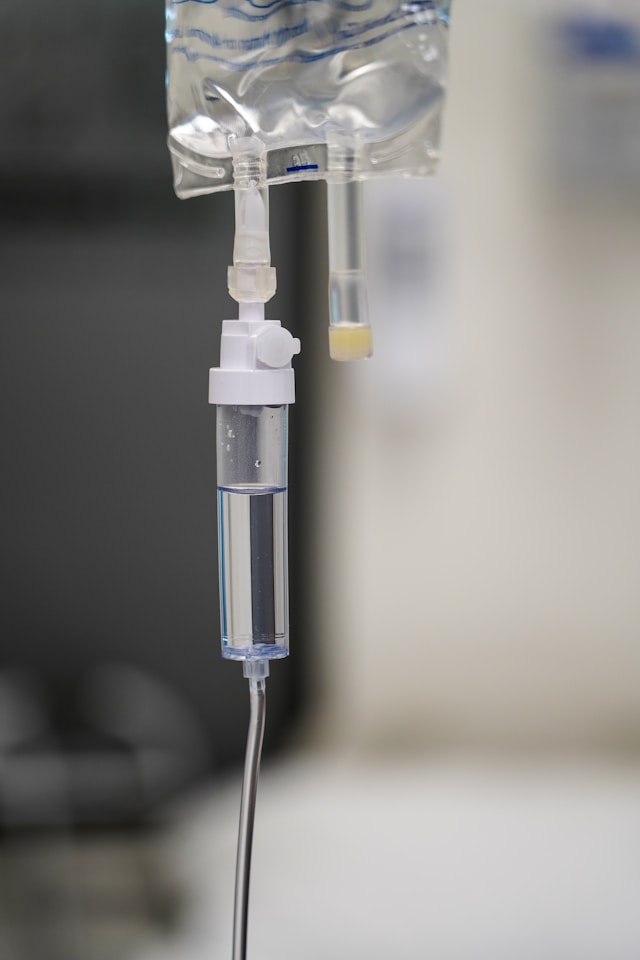
Infusion Therapy for Lupus


Dr. Chen is a board-certified immunologist with over 15 years of experience treating autoimmune and immunodeficiency disorders. She specializes in IVIG therapy and has published extensively on immune system treatments.
Medical Disclaimer
Systemic lupus erythematosus (SLE), commonly called lupus, is a complex autoimmune disease where your immune system attacks healthy tissues throughout your body, causing inflammation and damage to joints, skin, kidneys, blood cells, brain, heart, and lungs. While oral medications like hydroxychloroquine and corticosteroids form the foundation of lupus treatment, infusion therapy offers important options for patients with moderate to severe disease who need stronger immunosuppression. Biologic infusions can help control lupus activity, reduce organ damage, and allow many patients to reduce their dependence on high-dose steroids.
Key Highlights
- Biologic infusion therapies for lupus include Benlysta and Saphnelo, which target specific immune pathways that drive lupus inflammation and flares.
- Infusion medications are typically reserved for patients with moderate to severe lupus who haven't achieved adequate disease control with standard oral therapies.
- Many lupus patients on infusion therapy experience fewer disease flares, reduced need for steroids, and improvement in symptoms like fatigue, joint pain, and skin rashes.
Understanding Lupus
Systemic lupus erythematosus is an autoimmune disease where your immune system loses the ability to distinguish between foreign invaders and your own healthy tissue. This leads to widespread inflammation and tissue damage that can affect virtually any organ system.
Lupus symptoms vary dramatically between patients and can include fatigue, joint pain and swelling, skin rashes (including the characteristic butterfly rash across cheeks and nose), fever, hair loss, mouth sores, chest pain, shortness of breath, kidney problems, blood disorders, and neurological symptoms. Disease activity fluctuates with periods of flares (increased symptoms) and remission (minimal symptoms).
According to the Lupus Foundation of America, approximately 1.5 million Americans have lupus, with 90% being women. Lupus most commonly develops between ages 15-44, though it can occur at any age. African American, Hispanic, Asian, and Native American women develop lupus at higher rates than Caucasian women.
Left uncontrolled, lupus can cause serious organ damage, particularly to kidneys, heart, and brain. Early diagnosis and aggressive treatment help prevent these complications and improve long-term outcomes.
Why Infusion Therapy for Lupus
Infusion therapy becomes appropriate for lupus management in several situations:
Inadequate Disease Control: When standard treatments (hydroxychloroquine, oral immunosuppressants, low-dose steroids) don't adequately control disease activity or prevent flares.
Steroid-Sparing Strategy: Many lupus patients require chronic corticosteroids to control inflammation, but long-term steroid use causes significant side effects. Adding biologic infusions can allow steroid dose reduction or discontinuation.
Moderate to Severe Disease: Patients with significant organ involvement, high disease activity scores, or frequent disabling flares often benefit from the stronger immunosuppression biologics provide.
Specific Organ Involvement: Lupus affecting kidneys (lupus nephritis), central nervous system, or causing severe blood abnormalities may require more aggressive therapy including infusions.
Preventing Disease Progression: Early use of biologics may help prevent the cumulative organ damage that develops over time in poorly controlled lupus.
The American College of Rheumatology guidelines recommend considering biologic therapy for lupus patients with persistently active disease despite standard treatment.
Common Infusion Medications for Lupus
Benlysta (Belimumab): The first biologic specifically FDA-approved for lupus. Benlysta is a BLyS-specific inhibitor that blocks a protein (B-lymphocyte stimulator) that helps B cells survive. By reducing B cell activity, Benlysta decreases the autoantibody production that drives lupus inflammation. Given as a 1-hour infusion every 4 weeks (after loading doses at weeks 0, 2, and 4). Also available as weekly self-injections for patients who prefer that option. According to the Mayo Clinic, Benlysta has helped many lupus patients reduce disease activity and steroid use.
Saphnelo (Anifrolumab): A newer biologic approved for lupus that targets the type I interferon pathway, which is overactive in many lupus patients. Given as a 30-minute infusion every 4 weeks. Clinical trials showed Saphnelo reduces disease activity and skin rashes in many patients.
Rituxan (Rituximab): Though not FDA-approved specifically for lupus (except lupus nephritis in some cases), Rituxan is sometimes used off-label for severe lupus, particularly with kidney involvement. It depletes B cells, reducing autoantibody production. Given as two infusions 2 weeks apart, repeated every 6 months or when disease activity returns. Infusions take 4-6 hours initially.
Cyclophosphamide (Cytoxan): A powerful immunosuppressant given by infusion for severe lupus, particularly lupus nephritis or central nervous system lupus. While not a biologic, cyclophosphamide infusions every 2-4 weeks for several months can achieve disease control in severe cases. Requires careful monitoring due to potential side effects.
What to Expect from Infusion Therapy
Pre-Treatment Evaluation: Before starting biologic therapy, you'll need comprehensive testing including blood work (complete blood count, kidney function, liver function, complement levels, autoantibody levels), urinalysis, and possibly imaging studies. Infection screening (tuberculosis, hepatitis) is also required.
Starting Treatment: Benlysta and Saphnelo follow regular monthly schedules (after Benlysta's loading doses). Your first infusion includes extra monitoring time to ensure you tolerate the medication well.
Timeline for Improvement: Lupus improvement with biologic therapy is often gradual. Many patients notice subtle changes within 4-8 weeks, but significant benefit typically develops over 3-6 months. Some symptoms like fatigue and joint pain may improve earlier, while others take longer.
Combination Therapy: You'll likely continue hydroxychloroquine and possibly other immunosuppressants along with your infusion biologic. The goal is often to reduce or eliminate steroids while maintaining disease control with biologics and other medications.
Monitoring Disease Activity: Your rheumatologist tracks lupus activity using clinical assessment, patient-reported symptoms, laboratory markers (complement levels, anti-dsDNA antibodies, inflammatory markers), and disease activity scoring systems.
Benefits of Infusion Therapy for Lupus
Patients who respond well to lupus biologics often experience:
Reduced Disease Flares: Fewer episodes of increased disease activity requiring treatment adjustments or hospitalizations.
Decreased Disease Activity: Lower overall disease activity scores, indicating better-controlled lupus.
Steroid Reduction: Ability to lower prednisone doses or discontinue steroids entirely, avoiding long-term steroid side effects like weight gain, bone loss, diabetes, and increased infection risk.
Improved Specific Symptoms: Reduction in joint pain and swelling, improvement in skin rashes and photosensitivity, decreased hair loss, and healing of mouth sores.
Reduced Fatigue: Many patients report significant improvement in the overwhelming fatigue that often accompanies active lupus.
Organ Protection: Stabilization or improvement in kidney function for patients with lupus nephritis, and prevention of damage to other organs.
Better Quality of Life: Overall improvement in ability to work, participate in activities, and maintain normal life routines.
Reduced Medication Burden: For some patients, effective biologic therapy allows simplification of their medication regimen.
The National Institute of Arthritis and Musculoskeletal and Skin Diseases emphasizes that individualized treatment including biologics when appropriate provides the best outcomes for lupus patients.
Potential Side Effects and Risks
Understanding potential risks of lupus biologics:
Increased Infection Risk: All immunosuppressive therapies increase susceptibility to infections. Upper respiratory infections, urinary tract infections, and other common infections may occur more frequently. Serious infections are less common but possible.
Infusion Reactions: Mild reactions (headache, nausea, rash, fever) can occur during or shortly after infusion. These are usually manageable with pre-medications and slower infusion rates. Severe reactions are rare.
Depression and Suicidal Thoughts: Benlysta carries a warning about potential psychiatric effects, though causality remains uncertain. Patients with history of depression should be monitored carefully.
Progressive Multifocal Leukoencephalopathy (PML): This rare, serious brain infection has been reported with Rituxan use, though it's extremely uncommon. Signs include confusion, difficulty thinking, memory loss, vision changes, or weakness.
Infusion Site Reactions: Mild reactions at the IV site can occur but are usually minor.
Potential Cancer Risk: Long-term immunosuppression theoretically increases cancer risk, though data specific to lupus biologics is limited and any increased risk appears small.
Drug-Specific Effects: Cyclophosphamide has more significant potential side effects including bladder toxicity, fertility effects, and bone marrow suppression, which is why it's reserved for severe disease and requires careful monitoring.
Your healthcare team monitors for these issues through regular appointments, symptom assessment, and laboratory testing.
Living with Lupus on Infusion Therapy
Sun Protection: Continue rigorous sun protection even if skin symptoms improve. Lupus patients remain photosensitive and UV exposure can trigger flares.
Infection Prevention: Practice careful hand hygiene, avoid sick contacts, stay current on vaccines (avoiding live vaccines while immunosuppressed), and report fevers or infections promptly.
Medication Adherence: Keep infusion appointments consistently and continue taking oral medications as prescribed. Inconsistent treatment increases flare risk.
Healthy Lifestyle: Regular gentle exercise (adapted to your energy levels and joint symptoms), balanced nutrition, adequate sleep, stress management, and avoiding smoking all support better lupus control.
Monitoring for Flares: Learn to recognize your personal flare warning signs and contact your rheumatologist early when symptoms worsen.
Mental Health: Address depression, anxiety, or other mental health concerns. Living with chronic disease is challenging, and psychological support is an important part of comprehensive care.
Cost and Insurance Considerations
Lupus biologics are expensive medications, typically costing thousands per infusion:
Insurance Coverage: Most plans cover FDA-approved biologics for lupus with prior authorization. Your rheumatologist's office will provide documentation of disease activity and previous treatments tried.
Copay Assistance: Benlysta and Saphnelo manufacturers offer copay cards that can reduce out-of-pocket costs significantly for insured patients.
Patient Assistance Programs: For uninsured or underinsured patients meeting income criteria, manufacturers may provide medication at no cost.
Foundation Support: The Lupus Foundation of America and other organizations can help connect patients with financial assistance resources.
Frequently Asked Questions
How effective is infusion therapy for lupus?
Effectiveness varies by medication and individual patient. In clinical trials, Benlysta led to significant improvement in about 40-50% of patients compared to placebo, with many able to reduce steroid use. Saphnelo showed similar or slightly better response rates. While these percentages might seem modest, for patients who respond, the improvement can be substantial. Not everyone responds to biologics, but many lupus patients achieve meaningful disease control that wasn't possible with standard therapy alone.
Can infusion therapy put lupus into remission?
Some lupus patients achieve remission (minimal or no disease activity) with biologic therapy combined with other medications, though this isn't guaranteed. More commonly, biologics help achieve "low disease activity"—well-controlled lupus with minimal symptoms, little or no steroid requirement, and prevention of organ damage. Complete cure of lupus isn't currently possible, but good disease control allows many patients to live relatively normal lives.
How long do you need to stay on lupus infusion therapy?
Most lupus patients require ongoing maintenance therapy to keep disease controlled. Stopping biologics often leads to disease flares within months. Some patients who achieve sustained remission may be able to reduce treatment intensity, but this should only be attempted under close medical supervision. Lupus is a chronic condition that typically requires long-term management, though treatment intensity may fluctuate based on disease activity.
What if Benlysta or Saphnelo doesn't work for my lupus?
If one biologic doesn't provide adequate benefit after a sufficient trial (typically 6 months or more), your rheumatologist may try the other biologic (switching from Benlysta to Saphnelo or vice versa), add or adjust oral immunosuppressants, consider Rituxan for refractory disease, or optimize other aspects of your treatment regimen. Finding the right combination of medications for lupus sometimes requires patience and multiple adjustments.
Can you have infusion therapy if you have lupus nephritis?
Yes, several infusion therapies are used for lupus nephritis (kidney involvement). Benlysta is FDA-approved for lupus nephritis and can improve kidney function in many patients. Rituxan is sometimes used for severe lupus nephritis. Cyclophosphamide infusions are an established treatment for severe lupus nephritis. Your nephrologist and rheumatologist will determine the most appropriate therapy based on your kidney biopsy results and disease severity.
Hope for Better Lupus Control
If you've been prescribed infusion therapy for lupus, it represents an important treatment option that may provide the disease control you've been seeking. While lupus is a challenging disease to manage, modern biologic therapies have given rheumatologists new tools to help patients achieve better outcomes.
Many lupus patients on biologic therapy experience fewer flares, less medication burden, and improved ability to participate in work, family, and activities they enjoy. With proper treatment and monitoring, living well with lupus is achievable.
Ready to explore infusion therapy options for your lupus? Find infusion centers experienced in lupus treatment near you to discuss whether biologic therapy might benefit your disease management.
Medical Disclaimer: This content is for educational purposes only and is not a substitute for professional medical advice, diagnosis, or treatment. Always consult your healthcare provider with questions about your medical condition or treatment options.
Article Statistics


Table of Contents
Article Statistics










